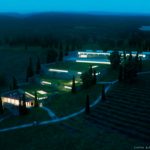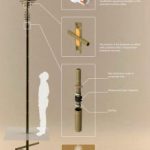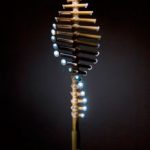Alexandra Gineva (Russia, Moscow region)
Moscow Institute of Architecture, Hogeschool voor Wetenschap en Kunst Sint-Lucas / student
Winery
The projected complex of the winery is for a location in the Krasnodar region, outside a village called Moldavanskoe, where it should become part of a multifunctional tourist complex, Lefkadia. This hilly terrain with small rivers and lakes is best suited to a spa resort, and to the planting of vineyards. So the best solution is to combine these functions and create a recreation complex, which will be the basis for wine making, wine culture and aesthetics.
Michal Wroblewski (Poland, Radomsko)
Institute of fine arts in Czestochowa / graduated
NTL Kurier
Creating the credits for TV news called Kurier, I wanted to show the principles on which the programme is based and present the cities in which NTL channel can be received. Radomsko is the information centre and it is surrounded by the other cities, regarding their geographical position. The whole project presents a symbolic map of pulsating circumferences, which suggest the flow of information. This project is a part of NTL channel’s layout and a part of my graduation work.
NTL Sport
The credits for the sport programme are created by means of lines which symbolise space and dynamics. However, the objects and shapes characteristic of sport are not be find here. This project is a part of NTL channel’s layout and a part of my graduation work.
NTL Pogoda
The credits for the weather forecast, in which we can see the typical elements of weather: an umbrella, the rain and the sun, interpenetrating each other. The wholeness has the complex colouring, oscillating between sky-blue, yellow, white, orange and red. This project is a part of NTL channel’s layout and a part of my graduation work.
Alberto Vasquez (Hungary, Budapest)
MOME, Moholy-Nagy University of Art and Design / graduated
‘Flow’ – public light for the Third World
‘Flow’ is a bamboo-made, self-maintaining public lighting system which operates on the principle of vertical wind turbine. The whole lamp disintegrates in nature except for the electronics – LEDs, wires and dynamo – which after time can be recycled without down-cycling. It can be installed in any place beyond the reach of the electric grid and solve the lack of public lighting there. Due to the simple junctions and mechanics, it can also be produced by the local unskilled workforce.
I was inspired by a problem that I experienced in Cartagena (Colombia). The coast-side of the city is busy and safe by day, but in the night it is dangerous because it’s abandoned. The reason behind this is the lack of public lighting at the seacoast. It is near deserted because few activities can be done in total darkness. But locals and tourists still have the desire to be at the seaside by night. If the coast stays busy after dark it won’t be dangerous anymore.
The electrical grid cannot be transmitted to the shores because of the attributions of soil and environmental conditions. The maintenance of the public lights and the building of the grid is too expensive – for such a developing country – as does the consuming of electricity.
In Colombia there is a need of lighting which is cheap, which can be installed at places beyond the power grid and which is economically sustainable. How do we get electrical energy for the lighting? The wind dominating the shores in the whole year is an ideal resource for the lighting. That’s why ‘Flow’ works as a vertical wind turbine – to maintain its own power. Therefore the energy consumption from the grid is zero. How will this be cheap? Bamboo is one of the easiest to find and cheapest to produce raw materials in Colombia and its utilization has no ecological impact even at medium serial number products. It was socially important that the lamp can be produced by the locals, thus it can integrate to the area’s cultural and economic rhythm. Due to the simple construction and mechanics of the Flow lamp, it can also be produced by the local unskilled workforce. Therefore the whole lamp can be manufactured locally. This makes it even cheaper because it circumvents most logistical and transportation costs. As it can be produced by the local workforce it can reduce unemployment – which affects 40% of Colombia’s population today. It can give jobs for poor and uneducated people and let the coast side of Cartagena be busy and safe by night.
During the research process I realized that there are lot of countries with similar issues. In Third World countries the lack of public lighting is a common problem. The reasons are that in these places the building of an electric grid is too expensive or not even possible. There are not enough resources at hand: not enough raw materials, money and skilled workforce for the production.
But there is a need of lighting which is cheap, can be installed at places which cannot reach the network and can be easily produced with local resources. At these places the cheapest and most plentiful raw material is bamboo, while the cheapest utility energy is wind energy.


















